A numerical analysis of Thermo–Hydro–Mechanical behavior in the FE experiment at Mont Terri URL: Investigating capillary effects in bentonite on the disposal system
IF 3.3
2区 工程技术
Q3 ENERGY & FUELS
引用次数: 0
Abstract
We investigated thermo–hydro–mechanical (T-H–M) coupled behavior observed during the full-scale heater emplacement experiment at the Mont-Terri underground research laboratory conducted in the Opalinus clay as part of the DECOVALEX-2023 Task C project. Utilizing the OGS-FLAC simulator, we created a three-dimensional model to simulate multiphase flow in the experiment, applying extended Philip and de Vries’ model and incorporating the anisotropic T–H–M properties of the Opalinus clay. The simulation, which included a ventilation process, spanned five years of heating experiments and successfully replicated the measured temperature, pore pressure, displacement, and relative humidity results in bentonite and host rock during the experiment. The analysis revealed that capillary pressure significantly influenced the pore pressure change in the host rock near the tunnel, while thermal pressurization became dominant with increasing distance. Consequently, we conducted a sensitivity analysis on a simplified model to evaluate the effect of capillary pressure on the disposal system. Capillarity is a dominant factor for the multiphase flow depending on the distance from the heat. Variations in capillary pressure were observed depending on the gas entry pressure and water retention model, indicating that the capillarity of unsaturated bentonite could inherently affect the T–H–M results within the disposal system.
对 Mont Terri URL 的 FE 实验中的热-水-机械行为进行数值分析:调查膨润土中的毛细管效应对弃置系统的影响
作为 DECOVALEX-2023 任务 C 项目的一部分,我们研究了在 Mont-Terri 地下研究实验室的 Opalinus 粘土中进行的全面加热器置入实验中观察到的热-水-机械(T-H-M)耦合行为。利用 OGS-FLAC 模拟器,我们创建了一个三维模型来模拟实验中的多相流,应用了 Philip 和 de Vries 的扩展模型,并结合了 Opalinus 粘土的各向异性 T-H-M 特性。该模拟包括一个通风过程,跨越了五年的加热实验,成功地复制了实验期间在膨润土和主岩中测量到的温度、孔隙压力、位移和相对湿度结果。分析表明,毛细管压力对隧道附近主岩的孔隙压力变化有显著影响,而随着距离的增加,热加压成为主要影响因素。因此,我们对简化模型进行了敏感性分析,以评估毛细管压力对弃置系统的影响。毛细管是多相流的主导因素,取决于与热量的距离。毛细管压力的变化取决于气体进入压力和保水性模型,这表明非饱和膨润土的毛细管性可能会在本质上影响处理系统内的 T-H-M 结果。
本文章由计算机程序翻译,如有差异,请以英文原文为准。
求助全文
约1分钟内获得全文
求助全文
来源期刊

Geomechanics for Energy and the Environment
Earth and Planetary Sciences-Geotechnical Engineering and Engineering Geology
CiteScore
5.90
自引率
11.80%
发文量
87
期刊介绍:
The aim of the Journal is to publish research results of the highest quality and of lasting importance on the subject of geomechanics, with the focus on applications to geological energy production and storage, and the interaction of soils and rocks with the natural and engineered environment. Special attention is given to concepts and developments of new energy geotechnologies that comprise intrinsic mechanisms protecting the environment against a potential engineering induced damage, hence warranting sustainable usage of energy resources.
The scope of the journal is broad, including fundamental concepts in geomechanics and mechanics of porous media, the experiments and analysis of novel phenomena and applications. Of special interest are issues resulting from coupling of particular physics, chemistry and biology of external forcings, as well as of pore fluid/gas and minerals to the solid mechanics of the medium skeleton and pore fluid mechanics. The multi-scale and inter-scale interactions between the phenomena and the behavior representations are also of particular interest. Contributions to general theoretical approach to these issues, but of potential reference to geomechanics in its context of energy and the environment are also most welcome.
 求助内容:
求助内容: 应助结果提醒方式:
应助结果提醒方式:


